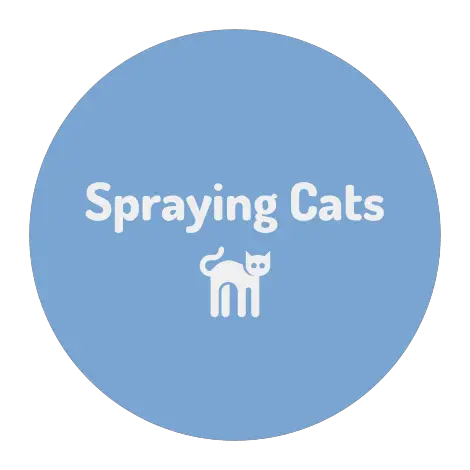Cat owners worldwide can attest to the frustration of trying to stop their feline friend from spraying indoors.
While marking territory is an instinct for cats, it can create an unpleasant living environment for their human companions.
Understanding the reasons behind the behavior and effective methods to address it can greatly improve the situation for both the cat and the owner.
Cats may spray for various reasons, such as medical issues, stress, or territory disputes with other animals in the home.
Identifying the root cause is crucial in finding a successful solution. This article provides valuable tips and techniques to prevent cats from spraying indoors, leading to a more harmonious living situation for everyone involved.
Providing adequate attention, care, and consistency is essential when addressing a cat’s spraying behavior.
By following the recommendations outlined in this article, pet owners can effectively reduce or eliminate this common issue.
Keep reading to learn how to stop a cat from spraying indoors and create a more peaceful and sanitary environment for the entire household.
Understanding Cat Spraying Behavior
Cat spraying is a natural behavior that serves as a way for cats to communicate with one another. Cats generally spray to mark their territory, attract potential mates, or to signal discomfort.
Understanding the reasons behind this behavior can assist in finding appropriate solutions for stopping it indoors.
One common reason for cat spraying is territorial marking.
When a cat feels that its territory is threatened by another cat or a new addition to the home, such as a new pet or family member, it may spray to establish dominance and signal its presence.
This behavior can be exacerbated if multiple cats are in the home and vying for dominance.
Cats also spray as a means of attracting potential mates. Unneutered male cats can be particularly prone to this as they have a strong drive to mate, and the smell of their spray can carry information about their breeding status to other cats in the area.
Female cats may also display this behavior, albeit less commonly, when they are in heat.
Stress or anxiety can also trigger cat spraying. Cats are sensitive animals, and changes in their environment, such as moving to a new home, alterations in their daily routine, or even furniture rearrangements, can cause stress.
This stress can manifest in various ways, with spraying being one of the more common expressions.
In some cases, medical issues can lead to frequent or inappropriate spraying. Urinary tract infections, bladder stones, or other health-related problems can cause discomfort that may prompt a cat to spray.
If the behavior seems out of the ordinary or doesn’t respond to usual interventions, it’s essential to consult a veterinarian for a thorough checkup.
In summary, cat spraying can be sparked by territorial instincts, mating behavior, stress, anxiety, or underlying medical issues.
By understanding the reasons behind this behavior, pet owners can employ strategies to reduce or eliminate indoor spraying in an informed and empathetic manner.
Monitoring The Cat’s Health
Routine Vet Checkup
It’s essential to take your cat for regular veterinary checkups. These visits will help ensure your cat remains healthy and free from potential health issues.
At least once a year, your cat should receive a comprehensive physical examination, vaccinations, fecal tests, and any necessary dental work.
Maintaining these routine visits can address any medical concerns contributing to your cat’s spraying behavior.
Identifying Medical Issues
Cats may sometimes spray indoors due to underlying medical issues. Addressing the underlying problem will help curb unwanted behavior in such cases. Some common health issues that could lead to spraying include:
- Urinary tract infections (UTIs): Cats with UTIs may experience pain and discomfort, which can result in spraying. If you notice your cat frequently visiting the litter box, straining to urinate, or producing small amounts of urine, consult your vet immediately.
- Feline interstitial cystitis: This condition affects the bladder and can cause similar symptoms to UTIs. Your vet will diagnose this issue through appropriate tests and suggest a suitable treatment plan.
- Arthritis: Older cats may develop arthritis, making climbing in and out of the litter box difficult. If you notice your cat struggling with mobility, seek veterinary advice.
Monitoring your cat’s health regularly and being attentive to any changes in behavior will help you address any potential medical issues before they lead to indoor spraying. Early detection and treatment of these problems can prevent spraying from becoming a chronic issue.
Managing The Cat’s Environment
Securing Territory
Securing their territory is one effective way to stop a cat from spraying indoors. Cats are territorial animals and tend to spray when they feel insecure. To make them feel more at ease, provide separate areas for each cat if there are multiple cats in the household:
- Designate separate sleeping areas with individual beds.
- Create separate feeding areas to avoid mealtime aggression.
- Allocate specific play zones and keep toys in their designated areas.
Another way to secure your cat’s territory is by increasing vertical space. Cats often feel safer off the ground, so providing various elevated spots can help:
- Install shelves or cat perches on walls.
- Add cat trees or towers in various rooms.
Reducing Stress Levels
Identifying and reducing the factors that trigger cat stress can help prevent spraying. Here are some practical steps for alleviating stress:
- Establish a routine: Maintain consistency in feeding times, litter box cleaning, and playtime to create a sense of predictability for your cat.
- Introduce gradual changes: When making any major changes in your cat’s environment (e.g., moving, new pet, or human addition to the family), introduce the changes slowly and give your cat time to adjust.
- Provide a safe space: Offer your cat a hiding spot or a quiet retreat to help them feel secure during stressful times.
- Use feline pheromones: Pheromone therapy, such as Feliway plug-ins or sprays, can help create a calming atmosphere for your cat. It mimics the natural facial pheromones cats release when they feel comfortable.
- Encourage positive associations: If your cat is spraying due to the presence of another animal, try to create positive experiences with them, like feeding them together or engaging them in playtime.
These strategies to manage your cat’s environment can help them feel more secure and reduce their need to spray indoors.
Implementing Training Reinforcements
Positive Reinforcement
One of the key methods to stop a cat from spraying indoors is to use positive reinforcement. This involves rewarding your cat for appropriate behavior.
For example, when you notice your cat using the litter box correctly, immediately offer a treat or praise. This will help your cat associate the positive experience with the desired behavior. Some tips to effectively use positive reinforcement are:
- Be consistent with the rewards
- Offer rewards immediately after the desired behavior
- Gradually decrease the frequency of rewards as the behavior becomes established
Setting Boundaries
Establishing clear boundaries for your cat to prevent indoor spraying is essential. Firstly, designate specific areas of your home as “cat-free zones” where your cat cannot go. This could include certain rooms or specific furniture pieces. To enforce these boundaries:
- Use deterrents: Employ physical barriers and repellents around the restricted areas to discourage your cat from entering.
- Provide alternatives: Make sure your cat has its designated space with a comfortable bed, toys, and scratching posts where it can feel secure and relaxed.
- Monitor and correct: Supervise your cat’s movements and gently but firmly correct its behavior if it attempts to enter restricted areas.
Remember, consistency is crucial for reinforcing the training. You can effectively stop your cat from spraying indoors by combining positive reinforcement with setting clear boundaries.
Using Specific Spraying Aids
It’s essential to consider using specific spraying aids to stop your cat from spraying indoors. These aids can be found in various forms, and their primary purpose is to deter the cat from marking its territory inside your home.
One effective spraying aid is pheromone-based sprays. These sprays contain synthetic pheromones that mimic the natural pheromones released by cats. When applied to areas where your cat tends to spray, these pheromones can create a sense of calm and contentment, making the cat less likely to feel the need to mark its territory.
Another helpful tool is motion-activated deterrents. These devices can be placed near areas where your cat has been marking its territory. When the cat approaches the area, the motion-activated device will emit an unpleasant sound or spray a harmless burst of air, effectively deterring the cat from that location.
Here are some additional spraying aids to consider:
- Odor neutralizers: These products help to eliminate the scent left behind by your cat’s urine, making the area less appealing for future marking. Apply these products to the affected surfaces, following the manufacturer’s instructions.
- Cleaning products specially formulated for cat urine: When cleaning areas where your cat has sprayed, it’s crucial to use a cleaner specifically designed to break down the compounds in cat urine. This will not only neutralize the odor but also help in preventing your cat from revisiting the area.
- Scratching posts and toys: Providing your cat with various types of scratching posts and toys can help alleviate the need to mark its territory. Scratching posts allow the cat to release its scent through its paws, while toys can distract and engage the cat, reducing stress and the need to spray.
Remember, finding the most effective solution for your cat may take some time and patience. Be sure to address the underlying causes of the spraying behavior, such as stress or medical issues, in conjunction with these spraying aids for the best results.
Professional Intervention
Sometimes, despite our best efforts, a cat may continue to spray indoors. In such cases, professional intervention can be an effective solution. A visit to the veterinarian should be the first step, as they can rule out any medical issues causing the spraying behavior.
A certified animal behaviorist or a professional cat trainer can be consulted if the cat is medically healthy. These experts can observe the cat’s behavior and environment, pinpointing the triggers that cause spraying.
They will then provide customized advice on managing and modifying the cat’s behavior, including changes in the home environment, establishing daily routines, and using positive reinforcement techniques.
Additionally, pheromone-based products such as synthetic cat facial pheromone diffusers can help reduce cat stress, decreasing the likelihood of spraying.
These diffusers can be prescribed by a veterinarian or bought over the counter. However, it is important to note that while pheromone diffusers can be beneficial, they may not completely solve the problem independently and should be used with other professional recommendations.
In conclusion, professional intervention can effectively address and resolve a cat’s persistent indoor spraying. By seeking the help of a veterinarian, behaviorist, or trainer, pet owners can learn valuable strategies tailored to their cat’s specific needs, ensuring a more harmonious living environment for both the cat and the owner.
[su_box title=”Affiliate Disclosure”]This website is supported by its readers. Please assume that all links are affiliate links. If you make a purchase from one of the links we will make a commission from Amazon. Thank you.[/su_box]




